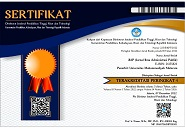Author Guidelines
Paper to be submitted or publications in the JIAP (Jurnal Ilmu Administrasi Publik) consist of several parts: Title, Abstract, Introduction, Literature Review (if any), Methods, Results and Discussion, Conclusions and Suggestions, Acknowledgments, and References.
Number of Pages
Articles are written at least 5 pages, including the Refresh List.
Paper Size
Articles written on A4 paper are 210mm wide (8.27 ") and 297mm long (11.69") with margins: Top: 1.5 cm, Left: 1.5 cm, Right: 1.5 cm, Bottom: 1.5 cm, and Space 1.15 pt.
Head (Title, Abstract)
- Title was written using a Century font with a letter size of 17 pt, a space of 1.0.
- The name of Authors uses the Century font with the letter size 11 pt, spacing 1.0. The first author is the main author or correspondence.
- Under the name of the author are written Departments/Study Programs, Universities, and e-mails of each author with a font size of 11 pt with a Calibri font.
- Writing the author may not indicate the name of the position (for example a Supervisor), academic degree (eg Prof, Dr, M.Pd, M.Sc, M.Sc, etc.) or membership of each organization.
- Every affiliate must be included, at least, the name of the institution or company and the name of the country where the author is (for example, the Information Center for Water Resources of DPU NTB, Indonesia)
- Abstract is written in a maximum of 200 words, with Century font, 9 pt, 1.0 space. Written in two languages namely Indonesian and English.
- Keywords are mentioned based on research variables.
Tables and Figures
- Tables are written with center or right align with 1.0 space.
- The table title is written using capital letters in the front letter of each word with a size of 10 pt, while the body of the table is 10 pt.
- It is recommended that the table be referenced in the paragraph before or after in the explanation.
- The title of the image is written in the middle with a font size of 10 pt, a space of 1.0.
- Pictures and Tables are numbered using Arabic numerals
- Figure are displayed with high resolution and placed centered.
- Use solid coloring that contrasts well with high resolution for display on a computer screen, as well as for prints that are black and white.
- Figure (graphs) are allowed to be colored.
Paragraph
- The paragraph must be organized. All paragraphs must be flat, which are both left and right and even.
- Each initial word in the title must be uppercase, except for short words such as, "a", "and", "in", "by", "for", "from", "on", "or", and the like.
- Sequential equations are followed by numbering numbers in parentheses with right flat margin, as in (1).
- Use the equation editor to make the equation.
- If the equation is long (lots of variables) to be tighter, use the slash (/), the rank function, or the right rank. Use parentheses to avoid confusion in giving fraction numbers.
- Make sure that the symbols in the equation have been defined before the equation or immediately follow after the equation appears. The symbol is typed in italics.
- Each table or image that includes a width of more than 1 column must be positioned at the top or at the bottom of the page.
- The figure may not use dots because there is a possibility that they cannot be printed in the original.
Conclusions and Suggestions
In this section, the author details the conclusions of the results of the discussion and data analysis and is advised to submit further research to the next researcher.
References / Bibliography
- Titles in the Numbered References section, use the APA style
- All reference items are 10 pt font size, 1.0 space.
- The numbering of reference items is typed sequentially in square brackets
- The minimum number of references is 10 references, with a minimum of 40% coming from journals/proceedings.
Book
[1] Fausett, L. (1994). Fundamentals of Neural Network. New York: Prentice Hall.
Journal
[2] Herbert, Riza, L. S, and Mukmin, A. (2011). Application of Backpropagation Neural Networks for Rainfall Forecasting. Information and Communication Technology, 2 (1), 1-5.
[3] Syaharuddin. (2015). Pengembangan Modul Praktikum Matlab. Jurnal Teori dan Aplikasi Matematika, 2(1), 12-20
Article / Module / Dictate
[3] Agriculture Sector. (2011). Risk Assessment and Adaptation to Climate Change in Lombok Island, West Nusa Tenggara Province. Mataram: NTB Agriculture Service.
Proceedings / Seminar Articles
[4] Syaharuddin, Vera, M., and Dewi, P. (2017). Development of Matlab Based Computer Programming Modules. Proceedings of Mataram IKIP National Seminar, Mataram, Indonesia, 12-14.
















.JPG)



.JPG)